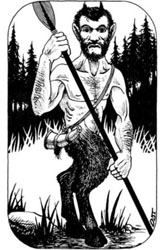As I have noted previously, undead in D&D represent at least three different broad categories of being: mindless corporeal, sentient corporeal, and noncorporeal undead. Zombies and skeletons fall into the first of these three categories, distinguished by the fact that they have no will of their own and are effectively automata under the control of their creator. They are also the weakest form of undead, a problem only for low-level characters.
It's well-known that zombies have their origin in Haitian legends, perhaps influenced by older African legends, but probably having more to do with the experience of slavery. In these legends, a recently-dead corpse is re-animated by an evil sorcerer, which it then serves as a mindless slave lacking all free will. The modern conception of the zombie, however, originates with George Romero's 1968 film Night of the Living Dead. Ironically, that film never actually uses the word "zombie", but it has become widely used since to refer to a selection of similar beings in films and other media.
Sunday, 22 December 2019
Saturday, 9 November 2019
D&D Monsters: Satyrs
Like centaurs, minotaurs, and harpies, satyrs have their origins in Greek myth. The original versions are wild nature spirits and, in particular, representations of unbridled male sexuality... this survives today in the psychological term 'satyriasis' for uncontrollable sexual desire in men. As with centaurs, this part-bestial nature is represented in their physicality, which combines various animal-like features with an otherwise human, masculine, body.
In later times, the Romans conflated satyrs with fauns, nature spirits from their own mythology that were part-goat part-man. This is quite different from how early Greek art shows them as looking, but it has become essentially universal in western lore since. Nonetheless, since "fauns" lack the rampant sexuality of satyrs, it was their name that C.S. Lewis used in the Narnia books, and his fauns were far more pleasant than Greek satyrs were said to be. Otherwise, "satyr" has generally been the more common term in fantasy, and that's the term that D&D uses.
In later times, the Romans conflated satyrs with fauns, nature spirits from their own mythology that were part-goat part-man. This is quite different from how early Greek art shows them as looking, but it has become essentially universal in western lore since. Nonetheless, since "fauns" lack the rampant sexuality of satyrs, it was their name that C.S. Lewis used in the Narnia books, and his fauns were far more pleasant than Greek satyrs were said to be. Otherwise, "satyr" has generally been the more common term in fantasy, and that's the term that D&D uses.
Subscribe to:
Comments (Atom)

